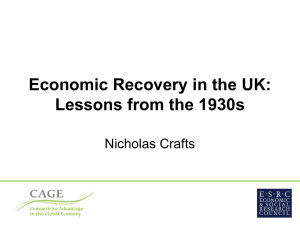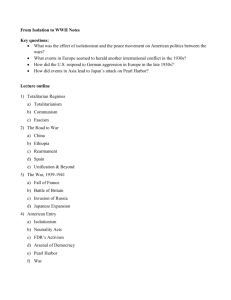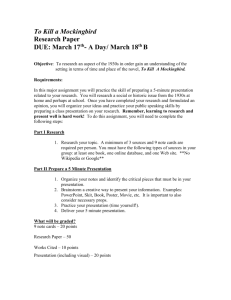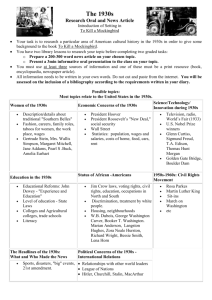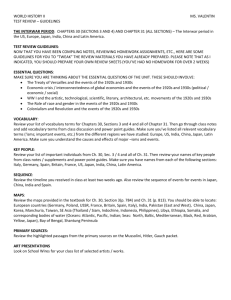Escaping liquidity traps: Lessons from the UK’s 1930s escape Nicholas Crafts
advertisement
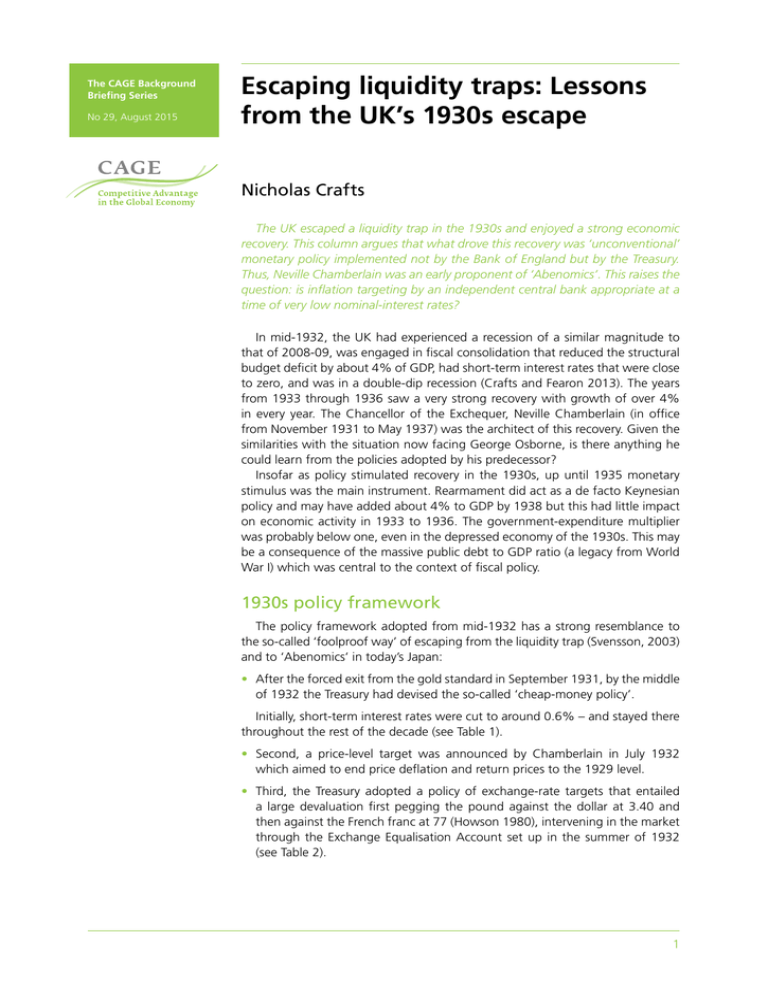
The CAGE Background Briefing Series No 29, August 2015 Escaping liquidity traps: Lessons from the UK’s 1930s escape Nicholas Crafts The UK escaped a liquidity trap in the 1930s and enjoyed a strong economic recovery. This column argues that what drove this recovery was ‘unconventional’ monetary policy implemented not by the Bank of England but by the Treasury. Thus, Neville Chamberlain was an early proponent of ‘Abenomics’. This raises the question: is inflation targeting by an independent central bank appropriate at a time of very low nominal-interest rates? In mid-1932, the UK had experienced a recession of a similar magnitude to that of 2008-09, was engaged in fiscal consolidation that reduced the structural budget deficit by about 4% of GDP, had short-term interest rates that were close to zero, and was in a double-dip recession (Crafts and Fearon 2013). The years from 1933 through 1936 saw a very strong recovery with growth of over 4% in every year. The Chancellor of the Exchequer, Neville Chamberlain (in office from November 1931 to May 1937) was the architect of this recovery. Given the similarities with the situation now facing George Osborne, is there anything he could learn from the policies adopted by his predecessor? Insofar as policy stimulated recovery in the 1930s, up until 1935 monetary stimulus was the main instrument. Rearmament did act as a de facto Keynesian policy and may have added about 4% to GDP by 1938 but this had little impact on economic activity in 1933 to 1936. The government-expenditure multiplier was probably below one, even in the depressed economy of the 1930s. This may be a consequence of the massive public debt to GDP ratio (a legacy from World War I) which was central to the context of fiscal policy. 1930s policy framework The policy framework adopted from mid-1932 has a strong resemblance to the so-called ‘foolproof way’ of escaping from the liquidity trap (Svensson, 2003) and to ‘Abenomics’ in today’s Japan: • After the forced exit from the gold standard in September 1931, by the middle of 1932 the Treasury had devised the so-called ‘cheap-money policy’. Initially, short-term interest rates were cut to around 0.6% – and stayed there throughout the rest of the decade (see Table 1). • Second, a price-level target was announced by Chamberlain in July 1932 which aimed to end price deflation and return prices to the 1929 level. • Third, the Treasury adopted a policy of exchange-rate targets that entailed a large devaluation first pegging the pound against the dollar at 3.40 and then against the French franc at 77 (Howson 1980), intervening in the market through the Exchange Equalisation Account set up in the summer of 1932 (see Table 2). 1 Escaping liquidity traps: Lessons from the UK’s 1930s escape Real interest rates fell quite dramatically and very quickly and gold reserves almost doubled within a year. By the end of 1936, the money supply had grown by 34% compared with early 1932 (Howson 1975). The cheap-money policy followed the textbook approach for operating at the zero lower bound of seeking to reduce the real interest rate by raising inflationary expectations. A key aspect was that the Treasury under Chamberlain, rather than the Bank of England under Montagu Norman, ran monetary policy after the exit from the gold standard. The classic problem with the ‘foolproof way’, especially for central banks, is whether they can credibly commit to maintaining inflation once recovery appears to be under way. Because of its problems with fiscal sustainability, the Treasury was in a good position to persuade markets that it wanted sustained moderate inflation as part of a strategy to reduce the real interest rate below the growth rate of real GDP and to benefit from this differential in reducing the public-debt-to-GDP ratio. This reliance, based on ‘financial repression’, allowed more tolerance for lower primary budget surpluses and eased worries about ‘self-defeating austerity’ without a Keynesian approach to the public finances. Table 3 reports on the budgetary arithmetic that made the Treasury’s position credible. Under conditions of price deflation in the early 1930s, the required surplus to prevent the debt-to-GDP ratio from exploding was disastrously high. By 1934/5, growth was above the real interest rate on government debt and a modest primary budget deficit was consistent with fiscal sustainability. House building Obviously, for the cheap-money policy to work it needed to stimulate demand – a transmission mechanism into the real economy was needed. One specific aspect of this is worth exploring, namely, the impact that cheap money had on house-building. The number of houses built by the private sector rose from 133,000 in 1931/2 to 293,000 in 1934/5 and 279,000 in 1935/6 – many of these dwellings being the famous 1930s semi-detached houses which proliferated around London and more generally across southern England. The construction of these houses directly contributed an additional £55 million to economic activity by 1934 and multiplier effects from increased employment probably raised the total impact to £80 million or about a third of the increase in GDP between 1932 and 1934. House building reacted to the reduction in interest rates and also to the recognition by developers that construction costs had bottomed out; both of these stimuli resulted from the cheap-money policy (Howson 1975). Why was house-building so responsive in the 1930s? Two factors stand out. •First, the supply of mortgage finance grew rapidly and became more affordable in an economy in which there had been no financial crisis that curtailed lending. Building society mortgage debt rose from £316 million with 720,000 borrowers in 1930 to £636 million with 1,392,000 borrowers in 1937 when about 18% of non-agricultural working-class households were buying or owned their own homes. In these years, deposits fell in some cases to 5% and repayment terms were extended from around 20 to 25 or even 30 years reducing weekly outgoings by 15% (Scott 2008). • Second, houses were affordable to an increasing number of potential buyers. 2 Escaping liquidity traps: Lessons from the UK’s 1930s escape 85% of new houses sold for less than £750 (£45,000 in today’s money). Terraced houses in the London area could be bought for £395 in the mid-1930s when average earnings were about £165 per year. Houses were cheap because the supply of land for housing was very elastic which in turn meant that there was no incentive for developers to sit on large land banks. Underpinning the availability of land for house-building was an almost complete absence of landuse planning restrictions which applied to only about 75,000 acres in 1932 – the draconian provisions of the 1947 Town and Country Planning Act were still to come. Lessons for George Osborne So what lessons might George Osborne take from this experience? • First, and most obvious is that when at the zero-lower-bound, conventional inflation-targeting by an independent central bank may not be the appropriate framework for monetary policy. The issue goes beyond the current discourse, which is focused on whether the target should be revised either to a higher rate of inflation or something based on nominal GDP. Britain in the 1930s benefited from not having an independent central bank. The lesson seems to be that central-bank independence is not always, and may not be today, the best way to implement monetary policy. • Second, it would be nice in present circumstances to repeat the house-building boom of the 1930s. Clearly, this is unlikely since both mortgage availability and land-use planning rules are very different. This seems to point, in particular, to the desirability of liberalising planning laws. As recent research has shown, this legislation imposes big distortions on the housing market and if some of these were removed, then a large number of houses might be built as the economy adjusted to a new equilibrium (Hilber and Vermeulen 2012). Policy changes of this kind are, however, politically challenging and most unlikely to happen. Table 1. Interest Rates (%) Bank Rate Treasury Bill Rate Yield on Consols Real Short Rate Real Long Rate 19295.505.264.605.265.14 19303.422.484.488.638.01 19313.933.594.409.739.20 19323.001.493.755.117.24 19332.000.593.390.665.65 19342.000.733.100.804.26 19352.000.552.890.593.59 19362.00 0.58 2.93-2.861.22 19372.00 0.56 3.28-2.090.93 19382.00 0.61 3.38-2.560.99 Note: Real rates of interest are calculated on an ex-post basis. Real long rates are based on the yield of consols minus a three-year backward-looking weighted average of actual inflation rates; for further details, see Chadha and Dimsdale (1999). I am grateful to Jagjit Chadha for providing me with the data. Sources: Bank Rate, Treasury Bill Rate and Yield on Consols: Dimsdale (1981) Real interest rates: Chadha and Dimsdale (1999). 3 Escaping liquidity traps: Lessons from the UK’s 1930s escape Table 2. Exchange Rates (1929 = 100) Pound/Dollar Pound/French Franc Average Exchange Rate 1929 100.0100.0100.0 1930100.1 99.9 99.6 1931 93.393.293.7 1932 72.171.975.2 1933 86.868.277.0 1934103.8 62.0 75.4 1935100.9 59.9 74.5 1936102.3 66.9 77.7 1937101.8 100.5 84.7 1938100.7 137.6 86.9 Notes: Average exchange rate is weighted by shares of world trade in manufactures. Source: Dimsdale (1981). References Chadha, J S and Dimsdale, N H (1999), “A Long View of Real Rates”, Oxford Review of Economic Policy 15(2), 17-45. Crafts, N and Fearon, P (2013), “The 1930s: Understanding the Lessons”, in N Crafts and P Fearon (eds.) The Great Depression of the 1930s: Lessons for Today, Oxford, Oxford University Press, 45-73. Dimsdale, N H (1981), “British Monetary Policy and the Exchange Rate, 19201938”, Oxford Economic Papers 33(2), supplement, 306-349. Feinstein, C H (1972), National Income, Expenditure and Output of the United Kingdom, 1855-1965, Cambridge, Cambridge University Press. Hilber, C A L and Vermeulen, W (2012), “The Impact of Supply Constraints on House Prices in England”, London School of Economics Spatial Economics Research Centre Discussion Paper No. 119. Howson, S (1975), Domestic Monetary Management in Britain, 1919-1938, Cambridge, Cambridge University Press. Howson, S (1980), “The Management of Sterling, 1932-1939”, Journal of Economic History 40, 53-60. Middleton, R (2010), “British Monetary and Fiscal Policy in the 1930s”, Oxford Review of Economic Policy 26, 414-441. Mitchell, J, Solomou, S and Weale, M (2012), “Monthly GDP Estimates for Interwar Britain”, Explorations in Economic History 49, 543-556. Scott, P (2008), “Marketing Mass Home Ownership and the Creation of the Modern Working-Class Consumer in Interwar Britain”, Business History 50, 4-25. Svensson, L E O (2003), “Escaping from a Liquidity Trap and Deflation: the Foolproof Way and Others”, Journal of Economic Perspectives 17(4), 145-166. 4 Escaping liquidity traps: Lessons from the UK’s 1930s escape Annex Table 3. Fiscal Sustainability Data, 1925-1938 b i π g d b* 1925-9 average 6.78 4.72 -0.99 2.221.6365.71 1930 6.15 4.75 -0.40 -3.72 1.59214.12 1931 5.41 4.51 -2.40 -2.37 1.69812.88 1932 7.25 4.49-3.580.651.73612.88 1933 7.42 3.90 -1.40 4.741.7921.00 1934 6.76 3.58-0.684.781.731-0.90 1935 5.683.640.874.261.650-2.46 1936 4.953.950.554.151.587-1.76 1937 3.893.673.733.171.472-4.75 1938 1.563.622.770.421.4380.62 1933-8 average 5.043.671.673.591.612-1.38 Note: b* is the required primary budget surplus to GDP ratio to satisfy the condition that (change in d) = 0, where (change in d) = -b +d(i – π - g) and b is the primary budget surplus to GDP ratio, I is the average nominal-interest rate paid on government debt, and d is public debt to GDP ratio from Middleton (2010) database; π is the rate of inflation based on GDP deflator from Feinstein (1972); g is the 4th quarter real GDP growth rate, from Mitchell et al. (2012). 5 About CAGE Established in January 2010, CAGE is a research centre in the Department of Economics at the University of Warwick. Funded by the Economic and Social Research Council (ESRC), CAGE is carrying out a five year programme of innovative research. The Centre’s research programme is focused on how countries succeed in achieving key economic objectives, such as improving living standards, raising productivity and maintaining international competitiveness, which are central to the economic well-being of their citizens. CAGE’s research analyses the reasons for economic outcomes both in developed economies such as the UK and emerging economies such as China and India. The Centre aims to develop a better understanding of how to promote institutions and policies that are conducive to successful economic performance and endeavours to draw lessons for policy-makers from economic history as well as the contemporary world. This piece first appeared on Voxeu on 12 May 2013 http://www.voxeu.org/article/escaping-liquidity-traps-lessons-uk-s-1930s-escape VOX Research-based policy analysis and commentary from leading economists © 2015 The University of Warwick Published by the Centre for Competitive Advantage in the Global Economy Department of Economics, University of Warwick, Coventry CV4 7AL www.warwick.ac.uk/cage Artwork by Mustard, www.mustardhot.com
